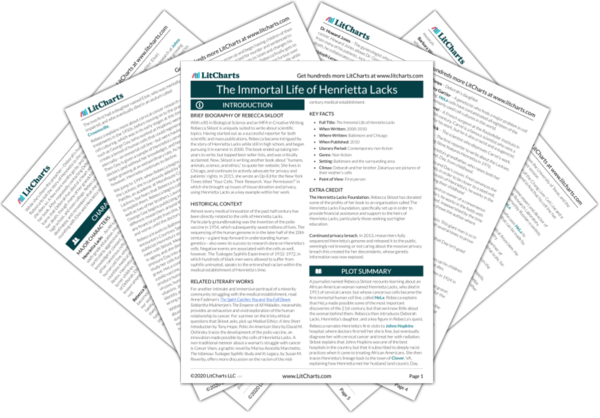Welcome to the LitCharts study guide on Rebecca Skloot's The Immortal Life of Henrietta Lacks. Created by the original team behind SparkNotes, LitCharts are the world's best literature guides.
Henrietta Lacks: Introduction
Henrietta Lacks: Plot Summary
Henrietta Lacks: Detailed Summary & Analysis
Henrietta Lacks: Themes
Henrietta Lacks: Quotes
Henrietta Lacks: Characters
Henrietta Lacks: Symbols
Henrietta Lacks: Theme Wheel
Brief Biography of Rebecca Skloot

Historical Context of The Immortal Life of Henrietta Lacks
Other Books Related to The Immortal Life of Henrietta Lacks
- Full Title: The Immortal Life of Henrietta Lacks
- When Written: 2000-2010
- Where Written: Baltimore and Chicago
- When Published: 2010
- Literary Period: Contemporary non-fiction
- Genre: Non-fiction
- Setting: Baltimore and the surrounding area
- Climax: Deborah and her brother Zakariyya see pictures of their mother’s cells
- Point of View: First person
Extra Credit for The Immortal Life of Henrietta Lacks
The Henrietta Lacks Foundation. Rebecca Skloot has donated some of the profits of her book to an organization called The Henrietta Lacks Foundation, specifically set up in order to provide financial assistance and support to the heirs of Henrietta Lacks, particularly those seeking out higher education.
Continued privacy breach. In 2013, researchers fully sequenced Henrietta’s genome and released it to the public, seemingly not knowing or not caring about the massive privacy breach this created for her descendants, whose genetic information was now exposed.







